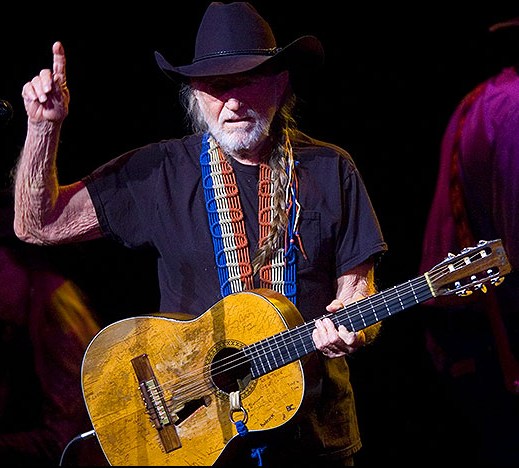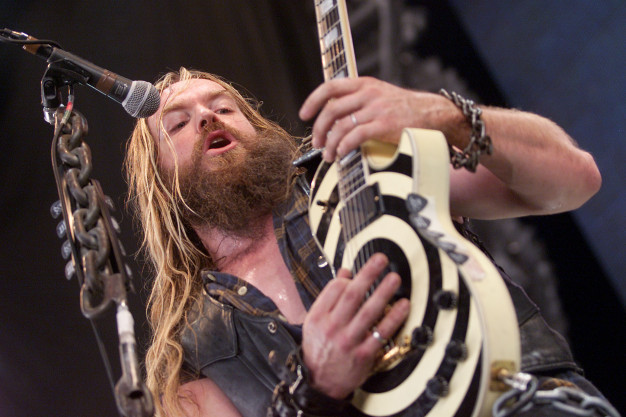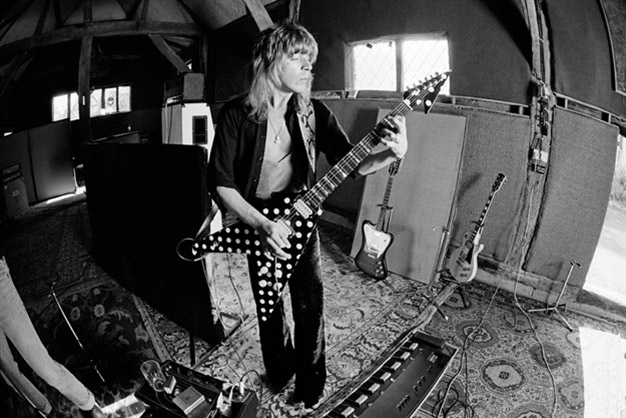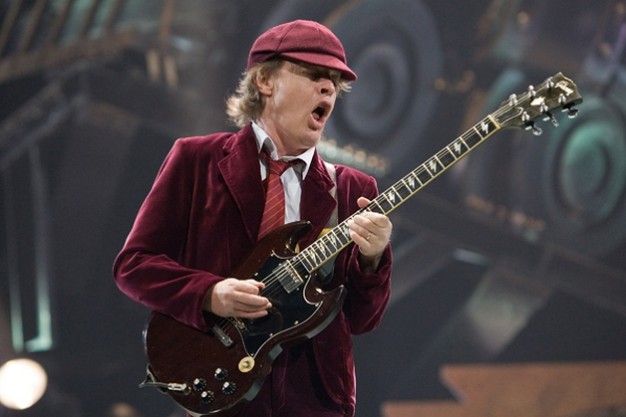[펌] (기타리스트의) 상징이 된 기타 Top 21
By Fernando Scoczynski Filho at 2:58 PM Friday, May 17th 2013
The Top 21 Most Iconic Guitars of All Time
Iconic Guitars, Lists
Some people will tell you that looks don’t really count for anything in rock music. Others will tell you that what you’re playing doesn’t mater at all – it’s all about how you’re playing. We’re here to tell you that those people are wrong, and give detailed reasons for why the most important instrument in rock music can have an impact that goes beyond the sound. Here are the twenty-one most iconic guitars in rock music:
 21. Kurt Cobain’s Fender Jag-Stang
21. Kurt Cobain’s Fender Jag-Stang
Though the Nirvana frontman had a fair share of guitars played (and smashed) throughout the band’s career, a couple of the Fender models he played tend to stand out: the Jaguar and the Mustang. Rather than having to pick either one of those, it’s only natural to feature the Jag-Stang, Cobain’s very own combination of both guitars. As the story goes, Kurt designed the guitar himself via a montage of polaroid photos.
He later pitched the Jag-Stang model to Fender, who had it made for him – though he only used it on rare occasions, for some reason.
After Cobain passed away, his blue model of the guitar was given to R.E.M.’s Peter Buck, who can be seen using it on the video for What’s the Frequency Kenneth?
 20. James Hetfield’s “EET FUK” ESP Explorer
20. James Hetfield’s “EET FUK” ESP Explorer
Even though James Hetfield has used several different Explorer guitars with Metallica, one stands out in particular: his “EET FUK” white model from ESP, which was used extensively while touring behind And Justice For All.
The words written on the guitar never got a proper explanation from its owner – though one isn’t necessary, really. After having its headstock broken several times, the Explorer was retired, though James picked it up again to record the track Suicide & Redemption on their most recent album Death Magnetic. White Explorers went on to become an easily identifiable element of Metallica’s live image.
 19. Rick Nielsen’s Five-Neck Hamer
19. Rick Nielsen’s Five-Neck Hamer
To be perfectly honest, there isn’t that much competition when it comes to iconic 5-neck-guitars. After the first double-neck came out, one could easily guess that things guitars would get bigger (and sillier) in the future. However, Rick Nielsen’s 5-neck model is one that looks just the right amount of ridiculous, and probably the only one with over three necks even worth a mention here – or anywhere.
18. Willie Nelson’s “Trigger”
Named after the famous horse that was featured in several of Roy Rogers’ Western films, Willie Nelson’s acoustic Martin N-20 guitar was bought in 1969, and stayed with him ever since. Though Trigger shows a significant amount of damage, its most recognizable one comes from gaping hole right in the middle of it – due in part to a lack of a pick-guard. Willie Nelson famously stated that “When Trigger goes, I’ll quit.”
If you want to read a very extensive telling of Trigger’s story, check out this Texas Monthly article.
 17. Bo Diddley’s “Twang Machine” Gretsch
17. Bo Diddley’s “Twang Machine” Gretsch
Frequently referred to as “that rectangular guitar”, Bo Diddley’s “Twang Machine” is the one most closely associated with the very early days of rock music on this list. The greatly influential blues / rock musician first created the rectangular-shaped guitar with Gretsch in 1958. He drew his inspiration from old homemade instruments by folk musicians, who made guitars out of cigar boxes. According to Diddley himself, the necessity for an instrument with a smaller body came after an incident with a Gibson L5, where he jumped around the stage a bit too much and eventually hit his groin with the guitar. We’re not sure how the Twang Machine’s sharp corners are any safer, though.
16. Prince’s “Cloud”
Originally custom-built by Minneapolis luthier David Rusan in 1983, the guitar was featured prominently in Prince’s Purple Rain film. Though some fans might argue in favor of his symbol guitar, the Cloud just looks sexier, more like something a regular musician might actually want to play.
 15. Matt Bellamy’s Black Kaoss Manson
15. Matt Bellamy’s Black Kaoss Manson
The most recent entry in the list comes from Muse frontman Matt Bellamy, and one of his many customized Manson guitars. Debuted in 2006, the Black Kaoss Manson guitar features a Korg Kaoss pad connected to a MIDI controller, allowing for some effects on a live setting. But it mostly just emits a cool light that makes the instrument stand out.
By the way, John Paul Jones had the same Kaoss pad on that monstrous bass he used with Them Crooked Vultures.
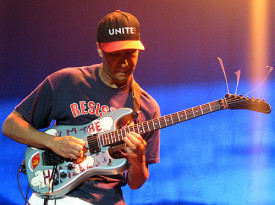 14. Tom Morello’s “Arm The Homeless” Custom
14. Tom Morello’s “Arm The Homeless” Custom
Tom Morello’s choice for standard tuning with Rage Against The Machine comes with his “Arm The Homeless” guitar. Morello ordered it from a custom guitar shop in Hollywood, down to his exact specifications – and it came out as “the shittiest guitar in the world,” in his own words.
He adds: “Everything about it was bad: it looked bad, it sounded bad, it was grotesquely overpriced, and over the course of the next two years I changed literally everything about it except for the piece of wood.” After several modifications, Morello eventually gave up on making the guitar sound exactly like he wanted, and instead focused on creating sounds with it – which worked out pretty well, we think. As for the words written on the body of the guitar, Morello claimed he enjoyed the juxtaposition of the strong line “arm the homeless” with images of the smiling hippos he drew himself.
13. Zakk Wylde’s “Bullseye” Gibson Les Paul
When Zakk Wylde started touring with Ozzy Osbourne, he knew he couldn’t simply show up with his cream Gibson Les Paul – though it sounded great, it was too similar to a model used by his predecessor, Randy Rhoads. Wylde himself explains how the Bullseye design came about: “I saw the poster from Vertigo, and thought that would be fucking awesome. So I explained it to my buddy Max, who ended up doing Slash’s guitar, but when I went down there for the photo shoot, I opened up the case and saw the Bullseye logo. I said, ‘Dude, what the fuck?’ I had drawn it on a piece of paper and everything, but it was too late anyway. So we did the photo shoot, and the rest is history.”
Say what you will about Kiss and their music, it’s pretty much impossible to deny how powerful the band’s image has been over the years, always making them the act to see live rather than listen to at home. But enough about that – Gene Simmons has a bass guitar shaped like a fucking axe. Originally conceived in 1978 as something to make his “Demon” character look a bit more iconic onstage (fire-breathing and spitting blood didn’t give Simmons quite the amount of attention he craved, apparently), it went on to be a fine example of “instrument shaped like ordinary object.”
It’s admittedly a bit silly, but no other band could pull this off better than Kiss. Here’s a video of Gene Simmons doing his “bass solo” – as you’ll see, the term only applies loosely:
11. Neil Young’s “Old Black” Gibson Les Paul
Neil Young’s “Old Black,” originally a Goldtop Gibson Les Paul, has been with the musician for over forty years, and was used as his main electric guitar on nearly all of his studio albums. Few musicians show quite this much dedication to a single instrument throughout their careers – Young even admitted to having back pains due to the weight of the guitar, but kept on playing it anyway.
10. Paul McCartney’s Höfner Bass
The second (and last) bass to be featured on this list, Paul McCartney’s violin-shaped bass is probably more remembered than any other instrument played by The Beatles. McCartney was reportedly pleased by how symmetrical the Höfner bass looked, allowing it to look like a regular left-handed instrument. He continues to bring it out onstage while touring, preventing pretty much any other bass player in the world from using the same model without looking like a hack.
9. Randy Rhoads’ polka-dot Flying V
Ozzy Osbourne’s post-Black Sabbath career would’n’t have started quite so well if it weren’t for Randy Rhoads, and this classic picture of the former lifting the latter couldn’t get much more symbolic. The guitarist co-wrote every song on Ozzy’s first two (and arguably most successful) records, Blizzard of Ozz and Diary of a Madman, before his tragic death in 1982. Rhoads’ image was closely associated with his polka-dot Flying V guitar, made by luthier Karl Sandoval – a transaction which can be verified via scans of the original receipts and drafts of the project.
8. Brian May’s “Red Special”
The instrument responsible for most of Queen’s guitar riffs comes with a nice backstory to it. Brian May designed and built the Red Special with his father, in 1963, mostly using wood from an old fireplace mantel. It comes with a few peculiarities: though it looks solid, its pieces are kept together in a such a way that it’s semi-acoustic, and the hardware is wired in odd ways, having on/off switches for each of the three pickups. Brian still uses the guitar to this day, after a few restorations, though he commonly plays replicas as well.
7. Eddie Van Halen’s “Frankenstrat”
The Frankenstrat came about as Eddie Van Halen’s attempt at combining the sound of a Gibson with the body of a Fender Stratocaster. After getting the body of the instrument at a discount price because it had a knot in the wood, Van Halen went on to build the guitar by himself, and eventually giving it the custom finish that became well-known and seen releases of official replicas over the years.
6. Tony Iommi’s “Old Boy” SG
The first of two Gibson SG-shaped models featured here, though not a Gibson SG itself, Tony Iommi’s “Old Boy” was built in his hometown of Birmingham by Jaydee Custom Guitars. Even though the guitar was first used during the Dio era of Sabbath, its crosses inlays fit right in with the band’s aesthetic, and Iommi continues to play the instrument nowadays. As for its extremely worn look, the guitarist explains: “It was built on John Diggins’s kitchen table and had to be finished very quickly. As a result, the coats of paint and finish did not have the time to cure properly. At a later date the guitar was left in a car in an extremely hot part of the world and a lot of the finish bubbled up, giving the guitar the look that has become familiar to all Sabbath guitar fans.”
5. Jack White’s Airline
It’s pretty well-known by now that The White Stripes’s basic color scheme worked in favor of the band, fitting perfectly with their music – something that Jack White had planned all along, always one to care for the visual aspect of his music. White’s Airline model, one of the three main guitars he used with the group, fit so well in the band that it almost seems custom-made. Originally manufactured by Valco and sold at low prices through Montgomery Ward catalogs, the guitar’s design looked so unique at the time that it immediately stood out and fueled claims that the Stripes were new rock icons to look out for. According to White, the reason for choosing it “was to prove that you don’t need a brand new guitar to have character, to have tone, and to be able to play what you want to play.”
 4. Keith Richards’ “Micawber” Fender Telecaster
4. Keith Richards’ “Micawber” Fender Telecaster
Arguably responsible for popularizing the Telecaster model quite a bit – and being associated with The Rolling Stones’ image in general – Keith Richard’s butterscotch-yellow 1953 Fender Telecaster Blonde came with some influence to his playing.
Richards famously removed the sixth string from the guitar and left it in an open G tuning, allowing for “two chords playing against each other” on songs like Brown Sugar. The guitarist explains: “One hangs on because you’ve just got to move one finger — or two at the most — to change the chord, so you’ve still got the other strings ringing. It’s a big sound.”
 3. Jimi Hendrix’s Monterey Fender Stratocaster
3. Jimi Hendrix’s Monterey Fender Stratocaster
This guitar holds a spot in the list for a unique reason: the fact that it’s probably best-known for how it ended up, rather than its actual appearance. At the Monterey Pop Festival in 1967, The Jimi Hendrix Experience were closing their set with an extended version of Wild Thing, when Hendrix knelt next to his Fender Stratocaster and set it on fire, giving place to one of the most beautiful, memorable moments in recorded rock history. Watch it below, around the 7:00 mark:
2. Angus Young’s Jaydee SG
Another guitar made by Jaydee Custom Guitars (yes, the same from Iommi’s Old Boy), Angus Young’s SG actually carries the name.
Though the AC/DC guitarist had previously used the Gibson SG Standard – and contributed immensely to its popularity – his unique version of the instrument came thanks to Jaydee, adding lightning bolt inlays to the neck of the red guitar, something that carried over to later custom-built versions of the instrument. Regardless of which version of the SG Angus Young is playing, it’s become nearly impossible to picture him without that red guitar – and, in some ways, the guitar without him.
 1. Jimmy Page’s Gibson Les Paul Standard
1. Jimmy Page’s Gibson Les Paul Standard
At this point, anyone would’ve guessed that the only musician truly missing here was Jimmy Page – though that fails to answer the question of which guitar of his we’d choose.
To be fair, all of his guitars look pretty damn iconic, even his oft-forgotten red Les Paul. A very strong case could be made for his double-necked Gibson SG, a model that Page helped popularize with performances of Stairway To Heaven, where he actually used both necks – something most other musicians using the instrument don’t really care about doing.
However, all things considered, the extra neck feels a bit like a gimmick when compared to the simple beauty of Jimmy Page’s Les Paul Standard (be it #1 or #2). The sunburst finish doesn’t really have anything unusual about it, making it seem like any musician could play the guitar and look as good, yet Page wore it so well that we can’t help associating it with Led Zeppelin.
Unlike most of the instruments here, what makes this Les Paul so iconic is not the way it looks by itself, but the way one guitar player managed to make it his own through his extraordinary music, and not much else. Maybe a violin bow helped a bit:
'악기 & Gear 이야기 > Guitar' 카테고리의 다른 글
| 사용했던 기타 리뷰 - 1. 에피폰 레스폴 스탠다드 (0) | 2014.10.26 |
|---|---|
| 저가 기타 쓰는 프로 기타리스트 (0) | 2014.10.26 |
| 완벽한 기타는 없다 (0) | 2014.09.26 |
| 사진으로 보는 PRS 탑의 등급 (0) | 2014.09.04 |
| Scandal Haruna Signature (0) | 2014.09.01 |
